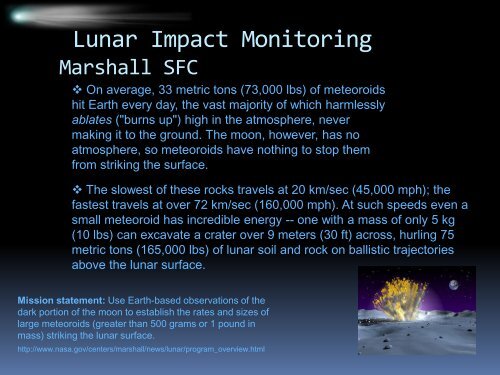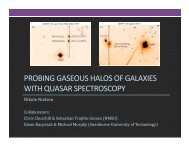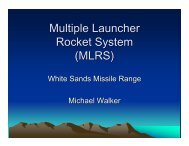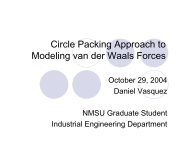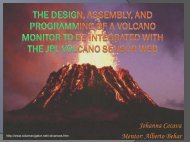Lightcurve Analysis and Photometry on CCD Images of Asteroids ...
Lightcurve Analysis and Photometry on CCD Images of Asteroids ...
Lightcurve Analysis and Photometry on CCD Images of Asteroids ...
You also want an ePaper? Increase the reach of your titles
YUMPU automatically turns print PDFs into web optimized ePapers that Google loves.
Lunar Impact M<strong>on</strong>itoring<br />
Marshall SFC<br />
On average, 33 metric t<strong>on</strong>s (73,000 lbs) <strong>of</strong> meteoroids<br />
hit Earth every day, the vast majority <strong>of</strong> which harmlessly<br />
ablates ("burns up") high in the atmosphere, never<br />
making it to the ground. The mo<strong>on</strong>, however, has no<br />
atmosphere, so meteoroids have nothing to stop them<br />
from striking the surface.<br />
The slowest <strong>of</strong> these rocks travels at 20 km/sec (45,000 mph); the<br />
fastest travels at over 72 km/sec (160,000 mph). At such speeds even a<br />
small meteoroid has incredible energy -- <strong>on</strong>e with a mass <strong>of</strong> <strong>on</strong>ly 5 kg<br />
(10 lbs) can excavate a crater over 9 meters (30 ft) across, hurling 75<br />
metric t<strong>on</strong>s (165,000 lbs) <strong>of</strong> lunar soil <str<strong>on</strong>g>and</str<strong>on</strong>g> rock <strong>on</strong> ballistic trajectories<br />
above the lunar surface.<br />
Missi<strong>on</strong> statement: Use Earth-based observati<strong>on</strong>s <strong>of</strong> the<br />
dark porti<strong>on</strong> <strong>of</strong> the mo<strong>on</strong> to establish the rates <str<strong>on</strong>g>and</str<strong>on</strong>g> sizes <strong>of</strong><br />
large meteoroids (greater than 500 grams or 1 pound in<br />
mass) striking the lunar surface.<br />
http://www.nasa.gov/centers/marshall/news/lunar/program_overview.html


